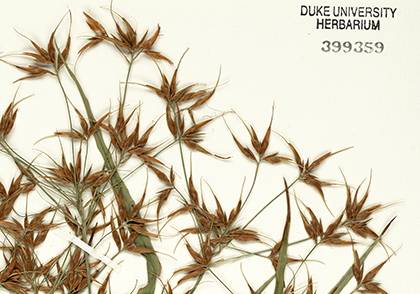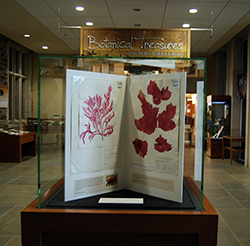Bringing Preserved Plants to Life
The making of a Perkins Library exhibit about Duke's Herbarium

As Layne Huiet walked through Perkins Library lobby admiring an exhibit, she dreamed about using the space to raise awareness of Duke's Herbarium, a collection of 800,000 preserved plants.
The Herbarium is a library of sorts with cabinets full of plants carefully pressed onto archival paper. Biologists use the plants to research how they've adapted and evolved and what impact humans have on natural landscapes. The Herbarium has space in the Biological Sciences and Phytotron buildings, but the specimens are unseen by most people.
Read More"I wanted to help people understand what a Herbarium is and why it is such a fantastic scientific resource," said Huiet, a senior researcher and herbarium collection manager for vascular plants.
It took 18 months, consultations with more than a dozen people and the concerted effort of a team of four curators from the Herbarium, but Huiet's dream came true. On April 19, 2013, the "Botanical Treasures from Duke's Hidden Library" exhibit opened in the Perkins Gallery near the entrance to Perkins Library.
Here's a behind the scenes look at what it took to make the exhibit happen:

Make the Pitch
Kathleen Pryer, director of the Herbarium, and Huiet invited Meg Brown, library exhibits coordinator at Duke to the Herbarium to persuade her to host an exhibit in Perkins. "I didn't even know we had a herbarium on campus until I got that email," Brown said.
Show Off the Visuals
Herbarium researchers showed Brown selections of the dried grasses and flowers pressed flat to show the intricate details of their petals, leaves, seeds and roots. They also pulled out envelopes of carefully preserved mosses, ferns and fungi. "The fact that the mushrooms were three dimensional was the clincher for me," Brown said. "Every good exhibit needs more than just books and text."
Find the Hook
Pryer knew that in October 2012, the Herbarium would publicly announce the naming of a new genus of ferns after Lady Gaga. This was a crucial combination of current scholarly work and pop culture to offset any misconception of the herbarium as a musty museum.
Pare it Down
A curator team, consisting of Pryer, Huiet, and two Duke Biology students, Tiff Shao and Anne Johnson, met monthly with Brown for six months to determine which of the 800,000 specimens from the Herbarium to highlight. Brown brought full-sized templates of 10 display cases to lay out on the worktables in the Herbarium to help the team imagine what might fit. As decisions were made, the team called upon other researchers in the Herbarium to write succinct, snappy explanations. "The layers of editing that go into an exhibit surprises most people," Brown said. "Writing less is more time consuming than writing more."

Create Some Buzz
While scientists edited the content, Jennifer Blomberg in the Library's Conservation Department created cradles and supports to display the exhibits attractively. Mark Zupan, the Library's graphic designer, chose the iconic imagery that united printed material, from an eight-foot-long banner hanging from the ceiling to the seven-inch-long bookmark for publicity.
To bring attention to the display, the Biology Department invited botanist Sandy Knapp from the Natural History Museum in London to give a lecture in April. Nearly 100 students, staff, faculty and local gardeners packed the classroom on the second floor of Perkins Library to hear the talk and then flowed into the Library lobby to pore over the glass-enclosed display cases.
The process of creating an exhibit requires passion, persistence and patience, according to Brown, the library exhibits coordinator at Duke, but the results offer a unique way to share scholarly research at Duke. "The library is all about sharing information, in many different formats," she said.
Brown welcomes new ideas and is planning projects for the three galleries the Library will have when renovations are done in 2015.
Meanwhile, when the "Botanical Treasures" exhibit ends July 14 and specimens are returned to their metal cabinets in the Herbarium, Huiet hopes the Herbarium's efforts will ensure that although they will be out of sight, they will not be out of mind.
"Perhaps now when people see an article about the Lady Gaga fern or other plant related topics they'll have a better understanding of how the scientists did the research," Huiet said.